The global palate has never been more attuned to the delicate, yet profound, philosophy of Japanese cuisine. Known as Washoku, this culinary tradition was officially recognized by UNESCO as an Intangible Cultural Heritage of Humanity, not just for its ingredients, but for its spirit of respect for nature and its seasonal rhythms. As of the Current Time of Writing, in November 2025, Japanese food is celebrated worldwide for its elegance, precision, and incredible health benefits.
At Spiritual Culture, we believe food is a direct link to a nation’s soul. The popularity of a dish is a measure of its successful cultural export—the way it carries tradition, discipline, and a sense of harmony across borders. The deep dedication of a sushi master (shokunin) or the meditative layering of flavors in a bowl of miso soup speaks to a spiritual discipline embedded in daily life.
This authoritative ranking moves beyond mere trend reports to assess the true global resonance of Japanese dishes. We evaluate their prominence based on widespread adoption, enduring historical significance, and the profound cultural values they embody. Join us as we count down the most popular Japanese foods that are, in fact, powerful ambassadors of Japanese spiritual culture.
Table of the Top 10 Japanese Foods by Global Cultural and Spiritual Influence (November 2025)
| Rank | Dish Name | Primary Cultural Value | Spiritual Value Index (1-10) |
|---|---|---|---|
| 1 | Sushi & Sashimi | The Art of Shokunin (Master Craftsmanship) | 10 |
| 2 | Ramen | Regional Diversity & Modern Comfort | 8 |
| 3 | Miso Soup | The Foundation of Balance (Ichiju-sansai) | 9 |
| 4 | Tempura | Elegance, Lightness, and Seasonal Purity (Shun) | 7 |
| 5 | Gyoza | Global Fusion and Communal Dining (Izakaya) | 6 |
| 6 | Udon Noodles | Historical Staple and Simple Sustenance | 7 |
| 7 | Matcha (Powder/Beverage) | The Way of Tea (Cha-no-yu) and Meditation | 9 |
| 8 | Onigiri (Rice Ball) | The Core Role of Rice (Gohan) in Daily Life | 6 |
| 9 | Okonomiyaki | Local Identity and Self-Expression (“Grilled as you like”) | 5 |
| 10 | Yakitori | Simplicity, Fire Craft, and Casual Gathering | 5 |
#10. Yakitori
Yakitori: The Essence of Simplicity and Communal Gathering
At number ten, Yakitori—small skewers of chicken grilled over charcoal—is an emblem of Japanese simplicity and the izakaya (casual pub) culture. While humble, the global adoption of Yakitori is significant, demonstrating how Japanese cuisine can elevate even the most basic ingredients through technique. Its popularity reflects a global appreciation for the wabi-sabi aesthetic applied to food: finding beauty in its unadorned, natural state. As of November 2025, Yakitori stalls and dedicated restaurants are thriving in major cities, serving as accessible entry points to Japanese flavors.
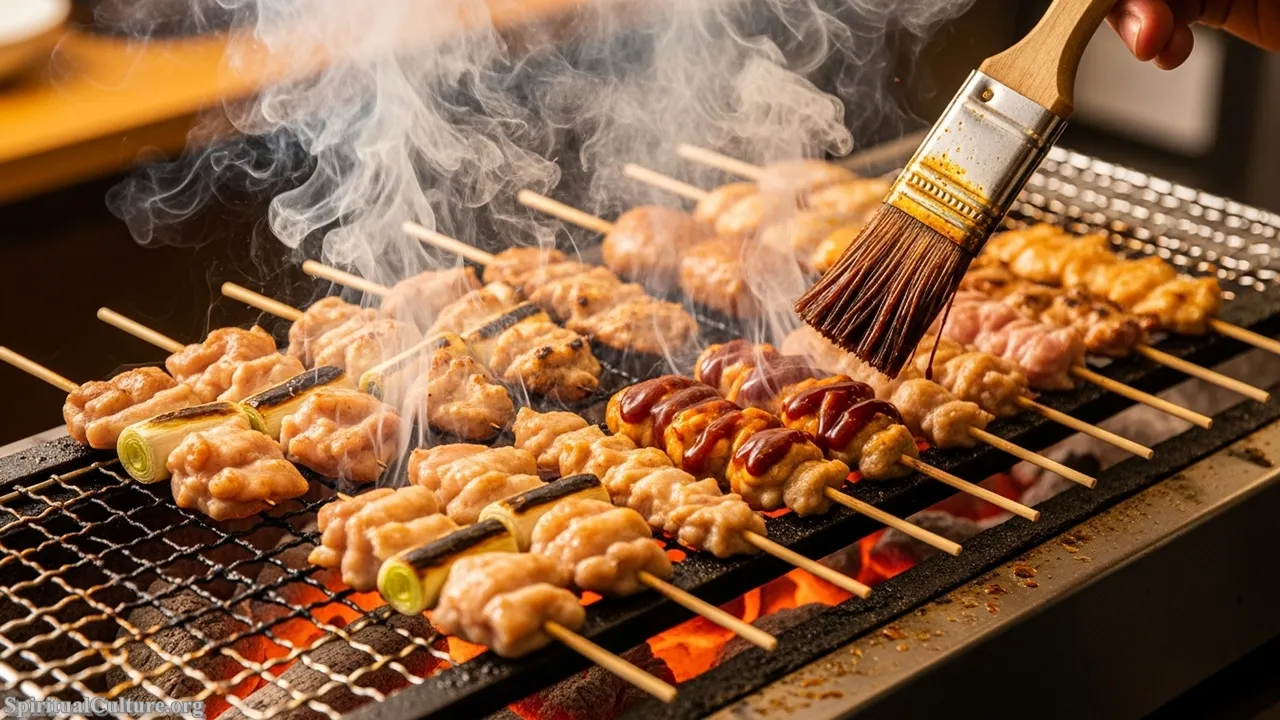
The spiritual value of Yakitori lies in the respect for the whole animal (often using nearly every part of the chicken) and the meditative quality of the grilling process. The chef, or yakitori-ya, meticulously controls the heat and the constant turning, ensuring perfection. Furthermore, it is intrinsically tied to the communal experience of the izakaya, where people gather to share stories and relieve the burdens of the day, fostering social harmony and human connection.
The moral lesson of Yakitori is clear: true flavor and spiritual fulfillment do not require complexity. They are found in the careful selection of quality, natural ingredients and the deep, shared experience of the meal. Its enduring popularity is a testament to the powerful cultural role of casual dining as a bedrock of community wellbeing.
Cultural/Spiritual Highlights
- The practice embodies Japanese resourcefulness and respect for ingredients.
- Deeply tied to the Izakaya (pub) culture, representing social release and harmony.
- Seasoned with traditional tare (sauce) or simply sea salt, prioritizing the chicken’s natural flavor.
#9. Okonomiyaki
Okonomiyaki: A Canvas of Regional Heritage and Personal Freedom
Okonomiyaki, often called a savory pancake or “grilled as you like it,” is a dish of fierce regional identity, primarily associated with Osaka and Hiroshima. Its structure is a blank canvas, reflecting the spirit of personal freedom in customization, which is rare in the typically rigid world of Washoku. This beloved comfort food has seen a rise in international specialty shops by November 2025, celebrated for its hearty, customizable nature and interactive cooking at the table.
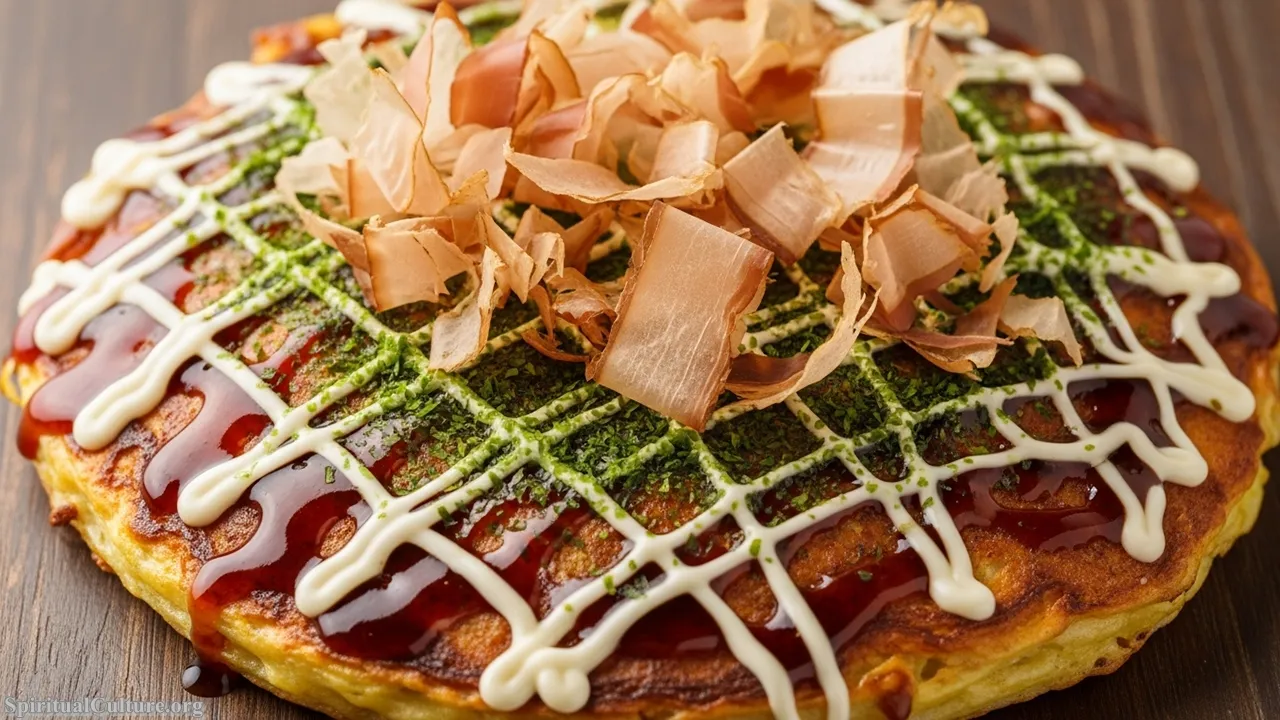
The spiritual impact of Okonomiyaki is its celebration of the local. It is a cultural expression of the cities it represents—a thick, satisfying meal contrasting with the delicate refinement of Kyoto-style cuisine. Furthermore, its name—okonomi (what you like) and yaki (grilled)—carries a philosophical message: that balance and delight can be found when tradition provides a framework for individual expression. It is a dish of democratic flavor, equally enjoyed by all classes.
In its preparation, whether cooked by the diner or a skilled chef, Okonomiyaki offers a moment of reflective, convivial joy. It reminds us that culture is a living entity that evolves and adapts without losing its essential nourishment. The simple act of creating your own perfect bite is a small, satisfying ritual.
Cultural/Spiritual Highlights
- Named for the freedom of choice (okonomi) in its ingredients and preparation.
- Represents strong regional culinary pride (Osaka vs. Hiroshima styles).
- It is an inherently interactive and communal dining experience.
#8. Onigiri (Rice Ball)
Onigiri: Simplicity, Utility, and the Spiritual Core of Rice
The humble Onigiri, a hand-formed ball of steamed rice often wrapped in nori (seaweed) and filled with simple savory ingredients like salted salmon or pickled plum (umeboshi), is number eight. Its global reach, often through convenience stores and bento boxes, belies its deep cultural significance. It is the original portable food, nourishing travelers, soldiers, and laborers throughout Japanese history and remains an essential staple in November 2025.

Onigiri’s spiritual impact derives from its use of gohan (rice), the sacred staple of Japan. To form rice by hand is an act of simple creation, providing physical and cultural sustenance. The triangle or round shape is often seen as protective, embodying a mother’s care for her family by placing a nourishing core within the rice. It is the food of pure necessity and mindful simplicity, demanding no pretense or elaborate setting.
The preservation value of Onigiri lies in its accessibility. It is the one dish that maintains the integrity of traditional Japanese eating habits in the face of modern complexity, teaching the moral lesson that the most profound nourishment often comes from the most elementary sources. Its presence in modern life ensures that the cultural rhythm of rice remains unbroken.
Cultural/Spiritual Highlights
- Emphasizes gohan, the spiritual and dietary cornerstone of Japan.
- Traditionally hand-formed, embodying a simple, personal act of creation.
- A symbol of quick, yet complete, sustenance and care in the Japanese diet.
#7. Matcha (Powder/Beverage)
Matcha: The Way of Tea, Wellness, and Meditative Presence
While often consumed as a beverage, the powdered green tea known as Matcha is an unparalleled cultural export, making it number seven. Its rise to global prominence by November 2025 is not just a health trend; it is the worldwide adoption of the spiritual discipline of Cha-no-yu, the Japanese Tea Ceremony. This finely ground tea carries the weight of Zen Buddhist tradition, representing purity, tranquility, and harmony.

Matcha’s spiritual impact is profound and direct, centered on the principles of wa, kei, sei, jaku (harmony, respect, purity, and tranquility). The careful whisking of the tea and the quiet, deliberate consumption forces the practitioner to be entirely present in the moment. It is a meditative ritual that transforms an everyday act into a moment of intentional mindfulness. Globally, it has become a symbol of wellness, bringing a sense of calm and focused energy to millions.
The preservation value of Matcha is critical: its global commercial success ensures the meticulous cultivation practices in Uji and Nishio continue. The moral lesson it offers is that true value lies in the process and the present moment, teaching patience, discipline, and the deep, rich reward of quiet appreciation.
Cultural/Spiritual Highlights
- Central to Cha-no-yu (The Way of Tea), a foundational Japanese cultural ritual.
- Embodies the Zen principles of purity, harmony, and tranquility.
- Global trendiness in 2025 is directly tied to a search for mindful wellness.
#6. Udon Noodles
Udon Noodles: Historical Comfort and Seasonal Flexibility
Udon, the thick, chewy wheat flour noodles, are a historical staple that maintains a massive global following due to their satisfying texture and versatility. While Ramen has gained flashy international status, Udon, along with Soba, represents a more ancient form of noodle consumption in Japan, adapting to various regional broths and serving styles. As of the Current Time of Writing, Udon’s simple, wholesome character has cemented its place as a globally recognized comfort food.

The spiritual value of Udon lies in its role as an enduring, non-elite food source that sustained the populace through centuries. It is the culinary embodiment of flexibility and endurance. The different ways Udon is served—hot in a rich broth during winter (Kake Udon) or cold with a dipping sauce in summer (Zaru Udon)—reflects a deeply ingrained cultural sensitivity to the seasons (shun). This seasonal adaptability is a form of spiritual harmony with the natural world.
The reflection offered by Udon is one of simple, enduring goodness. It teaches that the most reliable forms of sustenance are often those stripped down to their most essential elements. Its history reminds us of the resilience of Japanese culinary tradition, evolving yet remaining true to its satisfying, chewy core.
Cultural/Spiritual Highlights
- Represents a historical staple, contrasting with the more modern Ramen tradition.
- Its preparation honors the principle of seasonal eating (shun).
- The satisfying, simple act of slurping noodles is a universal form of comfort.
#5. Gyoza (Potstickers)
Gyoza: Culinary Synthesis and the Joy of Shared Pleasure
Gyoza, the Japanese take on Chinese jiaozi (dumplings), sits at number five due to its phenomenal global reach as a universal appetizer and side dish in November 2025. This pan-fried, crunchy-bottomed delight perfectly exemplifies the Japanese genius for taking an outside influence and refining it into a new, superior art form. Gyoza is ubiquitous in izakayas and international casual dining, acting as a bridge between Asian culinary traditions.

The spiritual impact of Gyoza lies in its role as a food of synthesis, symbolizing Japan’s cultural openness and ability to adapt. Furthermore, its serving size and flavor profile make it a food of shared pleasure and communal experience, a core value in Japanese social harmony. Eating Gyoza, often paired with a drink, is an act of slowing down, sharing, and connecting with others, embodying the easy-going spirit of the izakaya.
The moral lesson of Gyoza is that tradition is not static; it is a dynamic process of refinement. Its story teaches us that cultural borrowing can lead to new forms of brilliance. The crisp-yet-chewy texture and the balance of its savory filling offer a perfect, miniature package of culinary harmony.
Cultural/Spiritual Highlights
- The Japanese adaptation of Chinese jiaozi, signifying cultural refinement.
- A mainstay of Izakaya culture, emphasizing sharing and sociability.
- The preparation requires precision: steaming the filling while crisping the bottom.
#4. Tempura
Tempura: A Study in Lightness, Precision, and “Shun”
Tempura is the world’s most recognized and respected deep-fried dish, earning the fourth spot for its dedication to precise technique and seasonal purity. Its origins may trace back to Portuguese traders in the 16th century, yet the Japanese elevated it to an art form, focusing on the light, gossamer batter. In November 2025, high-end Tempura-ya globally command immense respect for their mastery of this delicate process.
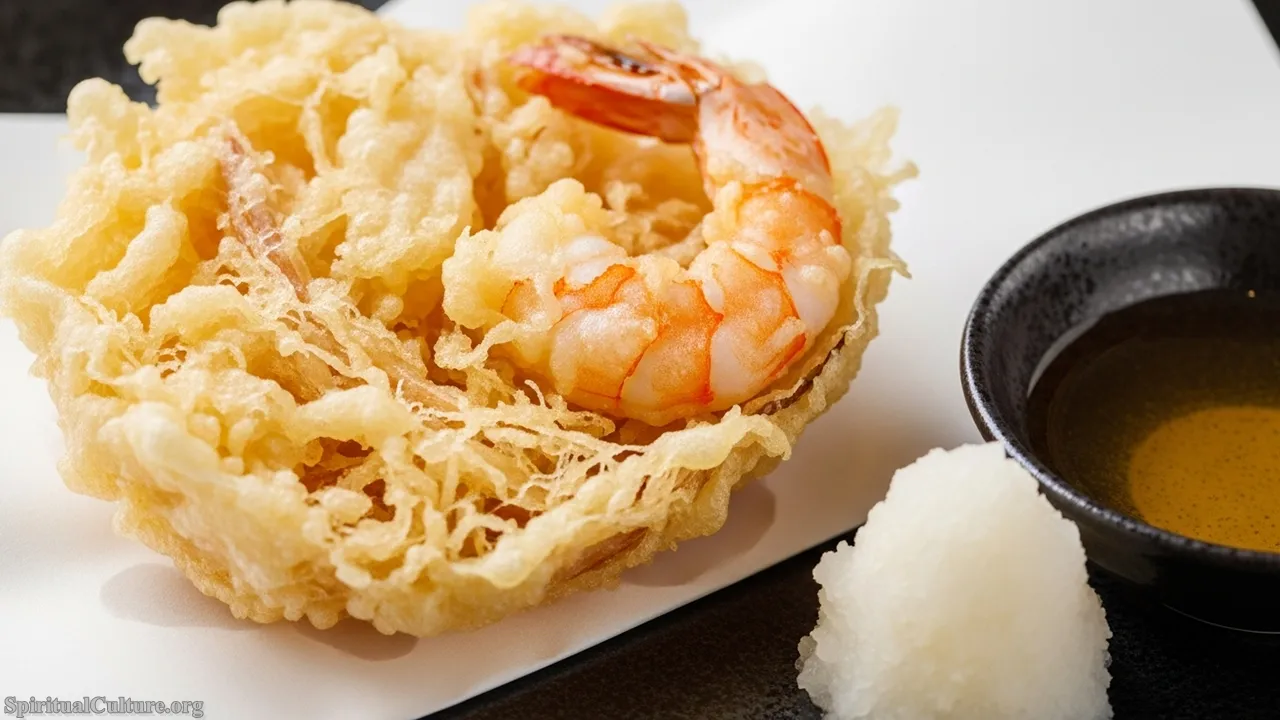
The spiritual impact of Tempura rests on the Zen-like focus on precision and lightness. The chef’s skill is judged by the thinness of the batter and the way it seals the ingredient’s natural flavor, respecting the purity of the material. Crucially, Tempura is always cooked using the finest seasonal ingredients (shun), turning a simple vegetable or piece of seafood into a celebration of the current moment and a momentary connection to the changing environment.
Tempura offers a profound reflection on the concept of ephemeral beauty. The perfect crunch of the batter is fleeting; it must be consumed instantly to be fully appreciated. This act of immediate appreciation is a reminder to value and respect the temporary perfection of the present, a central theme in Japanese aesthetics and culture.
Cultural/Spiritual Highlights
- Mastery of technique focuses on achieving extreme lightness and delicacy.
- Preparation is deeply connected to shun, the concept of peak seasonal flavor.
- The dish is a powerful example of Japanese refinement of foreign culinary techniques.
#3. Miso Soup
Miso Soup: The Daily Ritual of Balance and Wellness
Miso Soup is the quiet hero of Japanese cuisine and culture, taking the number three spot for its fundamental role in the daily diet and its deep philosophical significance. More than a simple side dish, it is the cornerstone of the traditional ichiju-sansai (one soup, three sides) meal structure, which promotes nutritional balance and mindful eating. Its fermented base provides a spiritual link to traditional Japanese health and longevity practices, recognized globally in November 2025.
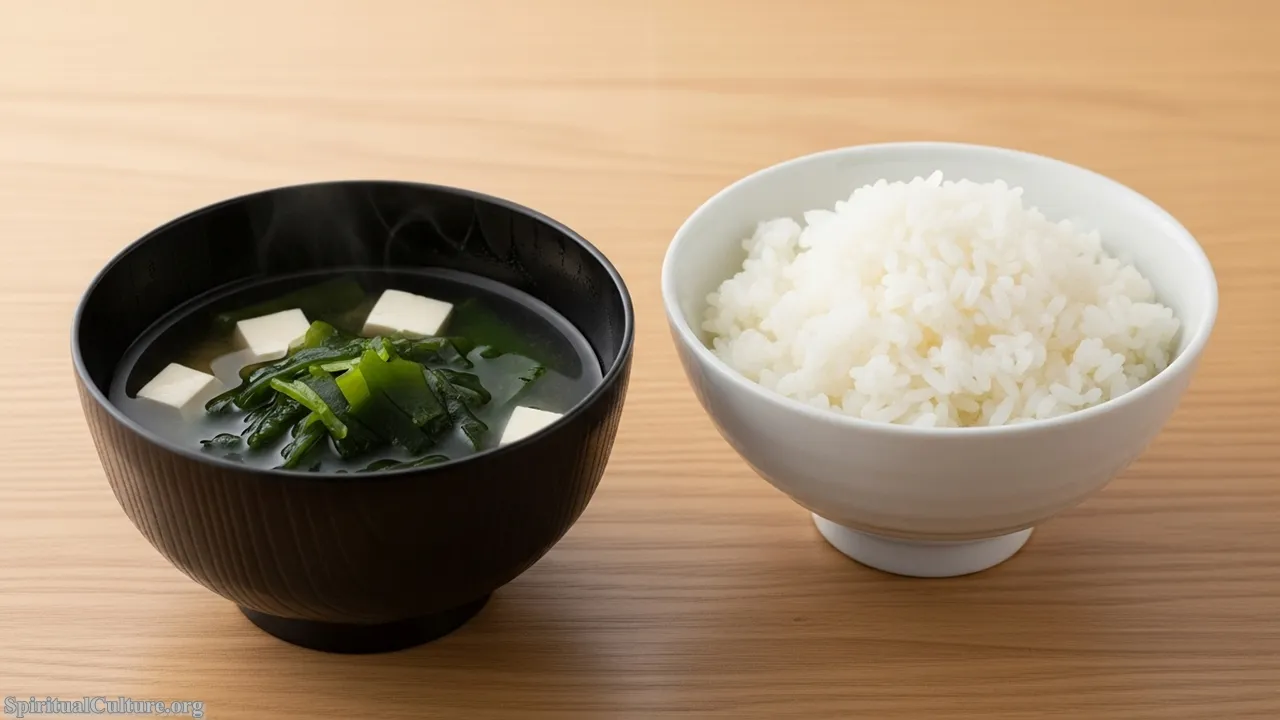
The spiritual value of Miso Soup is its embodiment of harmony and balance. The miso paste, made from fermented soybeans, is a source of umami—the fifth, savory taste—which is fundamental to Japanese flavor. The soup is a microcosm of the universe, combining ingredients from the land (tofu, vegetables) and the sea (wakame seaweed) in a single bowl. Its daily presence instills a rhythm of spiritual wellness and gratitude for nature’s bounty.
The reflection Miso Soup provides is one of profound daily gratitude. It teaches that the foundation of a healthy, balanced life is not complex, but consistent. By honoring this simple, nourishing broth, the practitioner honors the cultural heritage of Washoku and the ancestral knowledge of fermentation that has sustained the nation for centuries.
Cultural/Spiritual Highlights
- The “one soup” in the foundational ichiju-sansai (balance) meal.
- Its fermented soybean base (miso) is revered for spiritual and physical health.
- Embodies the principle of umami—the deeply savory essence of nourishment.
#2. Ramen
Ramen: A Global Phenomenon of Regional Soul and Comfort
Ramen, the hearty bowl of wheat noodles served in a rich broth with varied toppings, has become the definitive modern Japanese culinary export, securing the number two spot. Its global presence in November 2025 is immense, with dedicated shops celebrating regional styles (like Fukuoka’s Tonkotsu or Sapporo’s Miso). Though its origins trace back to China, Japan transformed it into a uniquely cultural product, embodying regional identity and a powerful sense of comfort.
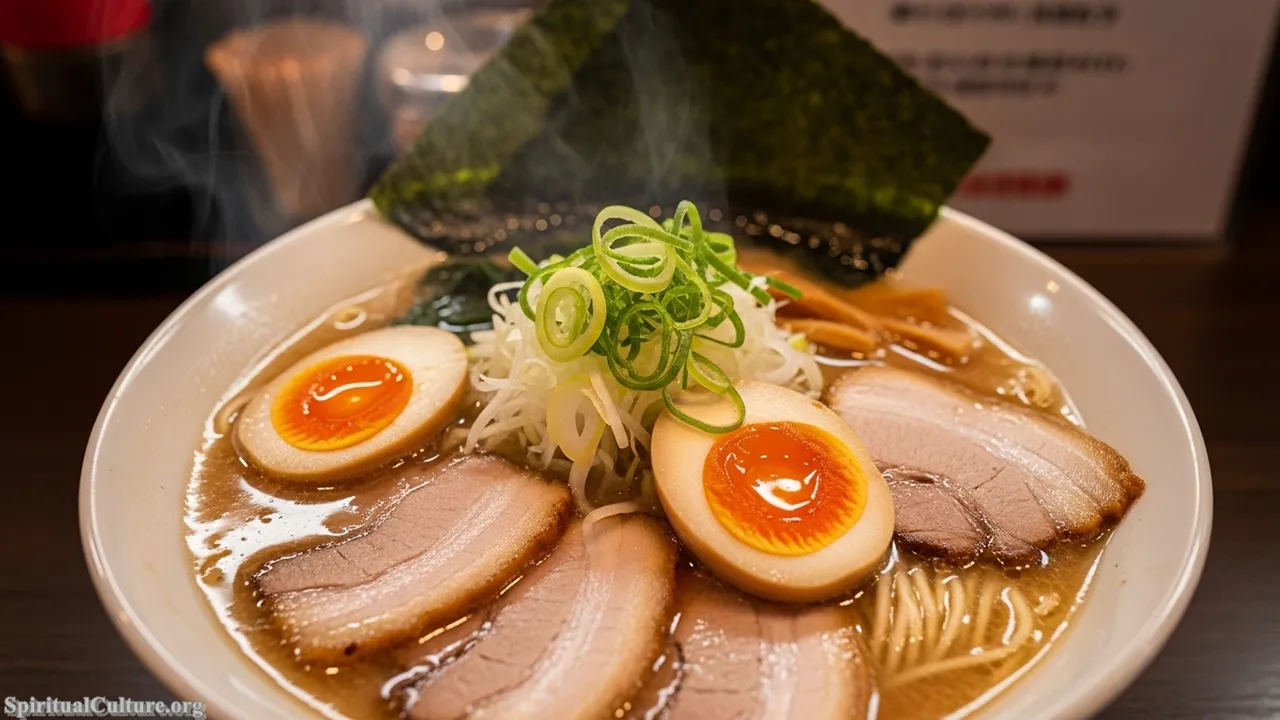
The spiritual impact of Ramen is its profound role as a contemporary “soul food.” The intense, dedicated creation of the broth—often simmered for up to 20 hours—is a monastic practice of patience and deep commitment by the chef. It serves as a spiritual antidote to the chaos of modern life, offering an immediate, hot, and all-encompassing comfort. Each regional style carries the history and flavor of its home, making a bowl of ramen a cultural pilgrimage.
Ramen’s reflection is one of powerful evolution. It teaches us that spiritual tradition can thrive by embracing change. The complexity of its flavor profile—a balance of fat, salt, and umami—is a metaphor for the complexities of life, all harmoniously resolved in one deep, satisfying experience. It is the communal comfort food of the 21st century.
Cultural/Spiritual Highlights
- Each bowl represents a distinct, localized cultural heritage (e.g., Tonkotsu, Shoyu, Miso).
- The extended, ritualistic preparation of the broth symbolizes the chef’s dedication.
- It is the quintessential modern comfort food and an emblem of Japanese cultural adaptability.
#1. Sushi & Sashimi
Sushi & Sashimi: The Apex of Shokunin, Purity, and Washoku
Unquestionably, Sushi and its sibling, Sashimi (raw fish without rice), stand as the most powerful and significant Japanese food culture exported globally. It is the worldwide face of Washoku and its recognition is absolute in November 2025. Its global domination is not just a matter of taste; it is the veneration of the cultural values of ultimate craft, perfection, and purity that the dish embodies.

The spiritual impact of Sushi is centered on the concept of Shokunin—the master craftsman who dedicates their life to the pursuit of perfection. This is not merely cooking; it is a spiritual discipline rooted in respect for the fish, the rice, the tools, and the customer. The strict, unyielding demand for freshness and seasonal correctness (shun) connects the diner directly to the purity of the ocean and the land. Each perfectly formed piece of nigiri is an act of meditative art, demanding full presence from both the creator and the consumer.
Sushi’s preservation value is the preservation of Japanese identity itself. It is a profound moral lesson that true art requires discipline, dedication, and an uncompromising respect for the natural world. By experiencing this dish, the world is exposed to the deepest spiritual philosophy of Japan: that life is about the meticulous, beautiful execution of a craft, no matter how small.
Cultural/Spiritual Highlights
- The ultimate expression of Shokunin (master craftsmanship) and dedication.
- A direct connection to nature’s purity, demanding the freshest, seasonal ingredients (shun).
- The global cultural ambassador for Washoku (UNESCO Intangible Cultural Heritage).
- Requires mindful, immediate consumption to appreciate the delicate balance.
Conclusion
The enduring popularity of these ten dishes is a powerful reflection of Japan’s successful cultural diplomacy. Whether through the monastic devotion of the shokunin crafting perfect sushi, the ancestral wisdom of Miso Soup, or the convivial comfort of a bowl of Ramen, Japanese cuisine offers more than just flavor. It offers a framework for living—a dedication to discipline, a sensitivity to the seasons, and a profound respect for ingredients.
As we move through November 2025, the world continues to draw spiritual and physical nourishment from these culinary masterpieces. The heritage of Washoku teaches us that the highest human achievement is often found in the quiet, meticulous acts of preparation that transform the raw elements of nature into a perfect, balanced harmony for body and soul. This is the ultimate gift of Japanese culture to the global table.



